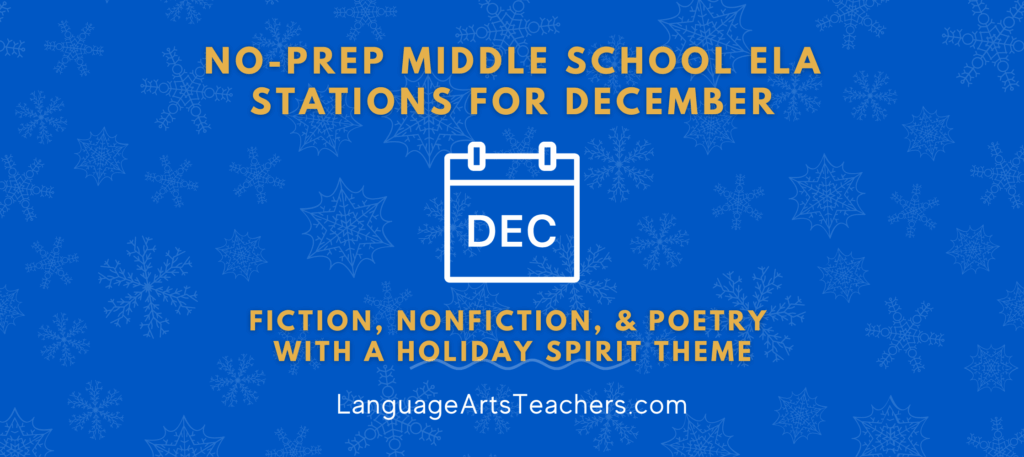Um… Just make them write everything?
When I first began teaching English / Language Arts, I was just trying to survive. I even had a principal at the time who expected to see the same thing happening in every classroom. Ugh.
So I did what the other ELA teachers did. If they all stood in line at the microwave to heat up their Lean Cuisines, so did I. If they graded in red ink, I bought extra red pens so my papers would look like theirs.
And if they gave a multiple-choice quiz, I gave the same lame-ass quiz.
Don’t judge!
It was my first teaching job and I didn’t want to mess up!
I remember passing out the vocabulary quiz each Friday, starting on one side of the room and working my way to the other as I handed the first person in each row a set of five quizzes to pass back. By the time I got to row six, the kids in rows one and two were done.
Seriously?
I spent twelve minutes in line at the copy machine waiting for my turn to run off all those copies just so that kids could circle a few letters and be done in two minutes?
Why was I working way harder to copy the stupid quiz while these kids got to scan over it and be done in two seconds?
And why were we giving such easy quizzes in the first place??!!
So halfway through that year, I totally quit giving those lame, dumb-ass quizzes.
There’s a process the brain goes through when linking a thought in the mind to a word on a paper. That process multiplies and expands infinitely when the student has to write a complete sentence. And then a paragraph. And then a series of paragraphs.
See, I’m not here to tell ya WHY kids should be writing… I’m here to give you a few ways to actually GET them writing consistently in your class.
But first I want to be clear about two things:
A) I didn’t invent all new lessons or anything like that to get my students writing consistently each day. I simply stopped making copies of things that required nothing more than circling answers.
B) There’s no way in helllll I actually read and grade all that stuff. Hint: make the students hi-light the absolute most crucial elements and then YOU only need to scan over those hi-lighted parts. Easy peasy. Plus, this forces your students to actually, um, check over their work since they have to mark it up!!!
So here are the five things I started doing right away to get the kids in my language arts class writing each day. You can do these, too.
And BTW, I have done this consistently with students in grades 6-12 over the past 15 years. It totally works. And any of this can be differentiated as needed. (Yay. My favorite word.)
Five Ways to Get Your Students Writing All the Time
1) Vocabulary Quizzes
2) Free-Writes
3) A-Z Writing Project
4) Short answer responses
5) Journaling (but not the kind you’re thinking)
Vocabulary Quizzes
- On the board or projector, write all of this week’s words. Add in a dozen or so old words from previous weeks or units. Maybe you end up with 20 words total.
- The student will choose any five of this week’s words + any five of the older words
- The students will use all 10 words to write a story or to create a comic strip where the characters use the words in their dialogue.
- The students will circle the terms and underline or highlight the context clues (when you grade, just look for the word and the meaning and grade that! It’s so fast!)
BTW, I let the students use their vocabulary notes to do this. The focus isn’t on memorizing the terms, it’s on knowing how to use them in a real situation. Plus, this gives more incentive to write notes! And seriously, it’ll take them waaaay longer to do this than a few minutes. That’s a good thing since it means they’re also spending more time interacting with the words themselves as well as with HOW to use them.
Free-Writes
Twice a week, give your students a free-writing topic. To make it easy on myself, I rotate between a picture/photo/cool image or a thought-provoking quote. I get these from Pinterest (of course, duh) and I keep them on a board dedicated to just those things I can use for free-writes. Just find my Pinterest boards for Language Arts free-writing by searching for “Quotes for Thinking & Writing” or “Images for Thinking & Writing” at Pinterest by going here.
Whether you teach 6th grade or 12th grade, start with 3 minutes. I go to Pandora and type in “new age” so the music is just instrumental and soft, and I start that playing. I set a timer for 3 minutes and I let it go. Here’s a link for the music I use.
My rules for the students include “keep your pencil moving at all times” and “if you don’t know what to write next, just copy the last word you have over and over until a new thought pops up in your head.” This totally works because then they’re not allowed to just sit there doing nothing.
I gradually work up to 20 minutes of writing in the upper grades. So like every three weeks or so I just add another minute or two.
A-Z Writing Project
The A-Z Writing Project is what I invented in response to the school district cutting our ELA class time down from 90 minutes to 60 minutes. Oh, and then they added in a mandatory 20-minute “guided reading” element– in sixth grade!!
I know, right?
So then that only left 40 minutes for actual on-level standards-based English/Language Arts instruction. No time for those awesome bell ringers I had! What to do with all the writing questions? What to do with all the prompts and questions that forced the students to spiral back to previous concepts taught and learned earlier in the year?
Answer: Take all those bell ringers and turn them into a series of 26 separate and rather unrelated writing prompts. The dates were replaced with letters of the alphabet (A-Z Writing Project, right?) and I printed them out from PowerPoint 2 per slide. I printed them in color and laminated them so they’d last a long time. I taped them in alpha order all around the room. A, B, and C were taped to the front of my desk and they continued along the wall all around the room with Y and Z taped to the inside of the classroom door.
Since we couldn’t do “official” bell ringers anymore, anytime the students finished their work early, like some are still finishing something and others are done and of course they NEVER remember to bring their library books to read… They just get up, grab their stapled packet of notebook paper, and go up to one of the letters and start writing.
It’s pretty common to see most of my kids sitting down working on an assignment and then several others quietly moving around the room as they respond to one or a few A-Z Writing Project questions. Then when the slower ones are ready to move on, we all come back together as a class to continue.
If you’re interested, click here to read my blog post all about just the A-Z Writing Project. To get the actual project and instructions for free, you can fill out this form below and I’ll get it to you.
Short Answer Responses
Ok, so you just finished reading a passage or a story or something. You know we all have those handouts with the ten questions they have to answer or we go to the end of the chapter in the book and we’ve got those five unit questions or whatever.
Instead of all that, just pick the two deepest, most intense critical thinking questions available. Copy those questions on the board. Have the kids talk about them in small groups. Then share as a class. Then have the kids take out a sheet of paper and choose one of the two to write about. I can almost guarantee that one question will take more work and more thinking on their part than answering five or ten dinky little multiple-choice questions ever would. ”
Journaling
But not the kind you’re thinking.
A co-worker and friend of mine started doing this. It’s not originally their idea. I’m sure they found it like on Pinterest or somewhere, but it doesn’t matter because it works really well.
So what you do is you get, say, 30 of those composition books (or 30 paper folders with brads that you can add a bunch of notebook paper to, or whatever you can get your hands on). You find rich, interesting quotes, excerpts, passages, articles, images, etc.) You print them off so they’re nice. Like… nice. Not fuzzy black & white with the yucky copy machine smears. Maybe your school has a laminator that you can use to really protect it so you can use it over again.
Anyhoo. So you now have like 30 of these little composition books, each with its own thought-provoking writing prompt. Students can read the prompt, read other kids’ responses to the prompt, and then ultimately they can write their own response to the original prompt.
For kids who literally have nothing to say about the prompt, they can at least summarize and “report on” what the other kids have written about the prompt. So no excuses to not do something. And they can also do this anytime they finish early with an assignment before the rest of the class is ready to move on…
They can do this on a day that you feel sick and almost stayed home (put on some soft music, turn off one of your light switches to dim the room a bit, and let them do this for 20 minutes or so, right?). They could also do this during “small group” time (like when you have to pull small groups of students for individualized instruction and the rest of the class needs something to work on). Hey, I’ve even selected 2-3 journals for a kid in AC or ISS or whatever your school calls it. Yeah, you get those emails that so-and-so is in the “alternative classroom” and needs work. Just send a few of those. No need to go running around trying to get something copied when maybe you were showing a video and then having a class discussion that day and therefore didn’t just have a worksheet laying around that you could send.



